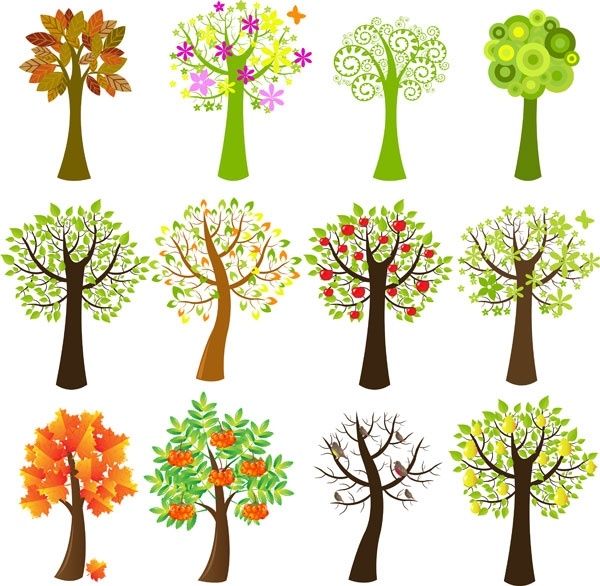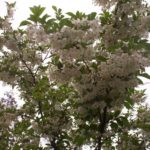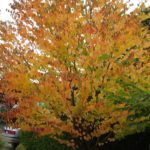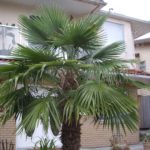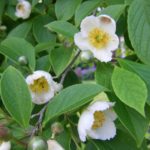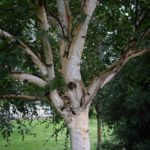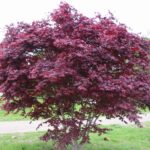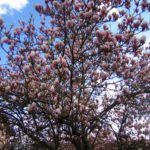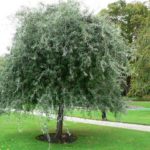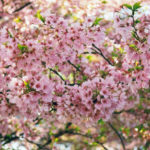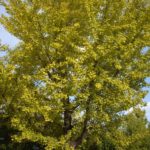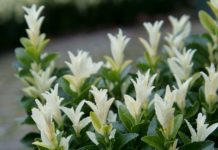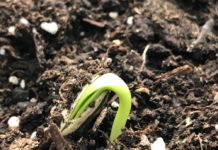1Styrax japonicus (Japanese snowbell tree)
Looking for a superb, moderate-growing, small tree for your garden, you can do no better than to pick the graceful snowbell tree. This exceptionally handsome deciduous tree is an excellent pick for a small- or medium-sized garden. It is relatively slow-growing, reaching only 25 to 30 feet (7.5 to 9 m) with a loosely rounded top at maturity. It takes about 10 years to reach 15 feet (4.5 m). In mid-June, it produces masses of fragrant, dainty, drooping, bell-shaped white flowers with tiny yellow stamens. It is a glorious picture when the tree is covered with these blooms. When it has finished flowering, the tree still presents a very charming image with its soft leaves covering an elegant framework of arching branches. In late summer, clusters of tiny, green, nut-like seeds can be seen dangling from the branches. Size: 25 feet (7.5 m) at maturity.
2Cercidiphyllum japonicum (katsura)
In the spring, this tree leafs out quickly, producing beautiful, tiny, coppery-red leaves that quickly turn an attractive shade of green. In the fall, the heart-shaped leaves change to a bright apricot-yellow with touches of red and pink. The tree produces a subtle but fascinating fragrance. Some describe it as coffee-like, others think it is cinnamon or the smell of burnt sugar. Still others are convinced the aroma is most similar to candy floss. Native to the temperate areas of Japan and China, the katsura is a favourite of landscape architects and garden designers for its elegance and suitability to the medium-sized garden. It was introduced into North America in the 1860s. The branches grow more upright than horizontal, creating a vase shape. New gardeners are sometimes put off choosing the katsura when they read that it can reach 60 feet (18 m). However, most trees grow quickly to 15 feet (4.5 m) and then take 10 or 20 years to reach 20 to 25 feet (6 to 7.5 m). There is a weeping variety that many gardeners love.
3Trachycarpus fortunei (windmill palm)
Popular in West Coast gardens because of the rise of interest in the tropical, jungle-like look, the windmill palm is hardy being native to Japan and China, which means it is capable of tolerating several degrees of frost. It is also completely indifferent to rain and even thrives in beach locations where it is exposed to salty air. Growing at a rate of about 12 inches (30 cm) a year, it will reach 10 to 15 feet (3 to 4.5 m) after 10 years, but under ideal conditions it can reach 30 to 50 feet (9 to 15 m) in time. In summer, it produces clusters of yellow flowers on short stems tucked among the leaves, followed by dark blue seed heads that germinate fairly easily to produce new plants. This hardy palm is considered a staple of the subtropical garden because of its beautiful, fan-shaped leaves and attractive trunk, which becomes covered with a matted, hair-like fiber as the tree matures. Size: 20 to 50 feet (6 to 15 m).
4Stewartia pseudocamellia (Japanese stewartia)
The beauty of this tree is that it has more than one season of interest. Its most appealing characteristic is that in summer it produces cup-shaped, camellia-like white flowers with showy orange-yellow anthers. But in fall, the dark green leaves turn beautiful shades of orange and burgundy-red, making it one of autumn’s real head-turners. If all that were not enough, the tree has something extra to offer in winter: as it matures, its branches and trunk develop attractive pink, brown and gray patches. A relatively slow-growing tree, it is the perfect size for a small- to medium-sized garden where it will grow to final mature height of 35 feet (10.5 m). Native to the woodlands of southwestern China and the hills of Nepal and India, stewartia is often found at nurseries under the name “stuartia” because at the time of its introduction to Britain in the eighteenth century it became associated with John Stuart, Earl of Bute. Size: 20 to 35 feet (6 to 10 m).
5Betula utilis jacquemonti (Himalayan birch)
If you were wondering which kind of birch to plant, your best choice is either the white-barked Himalayan birch (Betula utilis jacquemontii) or Young’s weeping birch (Betula pendula ‘Youngii’), depending on how much space you have. My pick would be the Himalayan birch, which is native to northern India and the Himalayas. After 20 years, it can reach a height of 30 to 40 feet (10 to 12 m), but it always remains slender and graceful. Its most attractive attribute is its brilliant white bark — the brightest white of any tree – which is especially striking in the winter landscape. Various cultivars have been developed over the years. Top names include ‘Silver Shadow’, ‘Jermyns’, ‘Moonbeam’, ‘Silver Queen’, ‘Dorrenbos’ and ‘Grayswood Ghost’.
6Acer palmatum ‘Bloodgood’ (Japanese maple)
There are many fine maples suitable for growing in small- and medium-sized gardens, but you won’t go wrong if you pick a cultivar of Acer palmatum. ‘Bloodgood’, is a great pick. It has large, dark red leaves and attractive blackish-red bark. It is an outstanding tree because the leaves retain their striking blood-red color all summer, and then turn a spectacular, fiery crimson in fall. With the graceful shape of its branches (a characteristic common to all palmatum maples), ‘Bloodgood’ also provides a delightful contrast for trees and shrubs with green leaves. You will also come across ‘Atropurpureum’ – a name given to a wide variety of seedlings of A. palmatum, all of which have red leaves. Few exceed 30 feet (9 m) at maturity; most grow to a little more than 20 feet (6 m). Other Japanese maples to consider include the coral-bark maple (A. p. ‘Sengo kaku’) and Koto No Ito, the harp-string maple, which I have also planted in my garden. Also keep an eye out for ‘Shishigashira’ (the lion’s mane or lion’s head maple); ‘Shojo’ (deep purple-red, slender leaves), all excellent trees. You will also come across ‘Atropurpureum’. This is a name given to a wide variety of seedlings of A. palmatum, all of which have red leaves.
7Magnolia x soulangeana (saucer magnolia)
English garden guru Christopher Lloyd called magnolias “the most glamorous and effective of all shrubs or trees”. He added, “There is room for at least one specimen in every garden.” We all have our favourite. The saucer magnolia (M. x soulangeana) is mine and is one of the most reliable. It flowers for four weeks in late spring with goblet-shaped blooms flushed with purplish-pink. It can be grown as a bush in the mixed border or as a stand-alone tree. It will reach 15 to 25 feet (4.5 to 7.5 m) at maturity. The foliage, which is a lush and pleasant green, comes after the flowers. It is sometimes called a “tulip tree” because of the shape and colour of the flowers. Names to look for include ‘Alexandrina’, ‘Lennei’, ’Bronzzoni’, ‘San Jose’, ‘Picture’ and ‘Rustica Rubra’. Magnolia x soulangeana grows happily in moisture-retentive, well-drained soil, where it can enjoy full sun in the mornings and semi-shade after lunch. Once established, magnolias can be difficult to relocate, so it is important to take your time picking the right spot. Size: 15 to 25 feet (4.5 to 7.5 m).
8Pyrus salicifolia ‘Pendula’ (weeping willow-leaved pear)
If you are ever lucky enough to visit Sissinghurst, the garden in Kent, built by Vita Sackville West and Harold Nicolson, you will find in the White Garden a superb example of this tree with a beautiful statue of a young girl under it. This delightful tree for the medium-sized garden has silvery gray leaves and a weeping form. It has become more appreciated in recent years as more gardeners discovered its virtues and versatility. When the wind catches the leaves in summer, the effect can be mesmerizing. It makes a good centerpiece in a border or a feature tree in a lawn. It can be evenly spaced to form an avenue and pruned into a very disciplined but graceful umbrella shape. I have seen it pruned very nicely in some Dutch gardens into a pillar shape and also used espaliered to create a silver-leafed hedge. Similar cultivars are ‘Silver Cascade’ and ‘Silfrozam’ (‘Silver Frost’). Size: 20 feet (6 m).
9Prunus x yedoensis ‘Akebono’ (Yoshino cherry)
There are dozens of types of Japanese ornamental cherry trees. The big question is which is the right one for your garden? The earliest to flower in Vancouver is the Whitcomb, followed by ‘Akebono’. For the best overall performance, it is hard to beat. It flowers in April, just when you are craving some cheerful spring colour, and produces a profusion of pink blooms that always evoke a gasp of admiration. More resistant than other ornamental cherries to diseases such as brown rot, ‘Akebono’ will grow 15 feet (4.5 m) tall and about as wide in 10 years, reaching 25 to 30 feet (8 to 9 m) at maturity. Other excellent picks include Accolade, Shirotae, Takasago, Shirofugen and Ukon. In spring, cherry blossoms have also become synonymous with the ephemeral nature of life. Stopping to appreciate the cherry blossoms is considered a national custom in Japan and sitting under a cherry tree in spring to picnic and view the blossoms (hanami) is a tradition catching on all around the world. Size: 25 to 30 feet (8 to 9 m).
10Ginkgo biloba (maidenhair tree)
One of the world’s oldest trees (there is fossil evidence dating back 150 million years), the ginkgo has developed an uncanny ability to cope with all sorts of difficult conditions – one reason it is so widely used as a street tree in city centres—it can deal with pollution and won’t die if neglected. Gardeners love the ginkgo for its fabulous fan-shaped green leaves that turn a superb golden yellow in fall. When a breeze rustles the tree, the leaves flutter like a thousand butterflies in flight. Very pretty. The tree has an erect, columnar habit, but the branches are sparse rather than compact and dense, which gives the tree a light and airy structure. Fruit of the female tree emits a foul smell when crushed underfoot, which is why it is always important to always make sure you get a male ginkgo, which does not produce fruit. There are two top cultivars to consider. ‘Autumn Gold’ is regarded as superior; ‘Princeton Sentry’ has a slightly more vertical, architectural shape. They both grow to 10 to 15 feet (3 to 4.5 m) in 10 years and then develop at a medium speed to reach 40 to 50 feet (12 to 15 m) at maturity.
